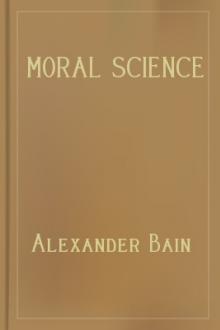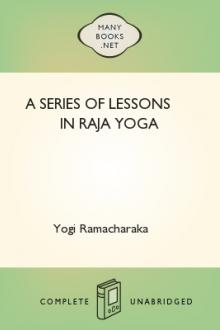Man's Fate and God's Choice by Bhimeswara Challa (feel good fiction books .txt) 📕

Read free book «Man's Fate and God's Choice by Bhimeswara Challa (feel good fiction books .txt) 📕» - read online or download for free at americanlibrarybooks.com
- Author: Bhimeswara Challa
Read book online «Man's Fate and God's Choice by Bhimeswara Challa (feel good fiction books .txt) 📕». Author - Bhimeswara Challa
The German atheist philosopher Schopenhauer said that universal compassion is the only guarantee of morality, and for that we must touch and tap the human heart. As the Indian mystic Osho puts it, “this is one of the mysteries: that the mind can speak, and knows nothing; and the heart knows everything, but cannot speak.”52 According to him, the center of human personality has shifted first from the navel to the heart and then to the brain, with disastrous consequences. He says that, “In Patanjali’s [the author of the famed Yoga sutras] days, the center of the human personality was not the brain; it was the heart. And before that, it was not even the heart. It was still lower, near the navel. The center has gone even further from the navel. Now, the center is the brain”53 Osho says that “a catharsis is needed because the heart is so suppressed, due to your brain which has taken over so much of your being that it dominates you. You have never laughed heartily; never done anything heartily. The brain always comes in to systematize; and the heart is suppressed.”54 And that “If the heart is unburdened, then the center of consciousness is pushed still lower; it comes to the navel. The navel is the source of vitality, the seed source from which everything else comes.”55 He concludes that “consciousness must be pushed down to the source, to the roots. Only then is
50 Edward O. Wilson. Consilience: The Unity of Knowledge. 1998. Alfred & Knopf. New York, USA. pp. 261-262.
51 Mind Power. The Deccan Chronicle. Hyderabad, India. p.6.
52 Osho. Mind is the Creation of Society; Heart Has No Logic. The Deccan Chronicle. Hyderabad, India. Sunday, 22 June 2008. II.
53 Osho. Shaking the Inner Snake Awake. The Psychology of the Esoteric. Accessed at: http://www.activemeditation.com/OtherModalities/Yoga/Yoga1.html#top
54 Osho. Why “Osho Active Meditations”? The Psychology of the Esoteric, #4. Accessed at: http://www.oshoatlanta.com/whyactive.html
55 Osho. Shaking the Inner Snake Awake. The Psychology of the Esoteric. Accessed at: http://www.activemeditation.com/OtherModalities/Yoga/Yoga1.html#top
there the possibility of transformation. The ultimate cannot be known through the brain because when you are functioning through the brain, you are in conflict with the roots.”56 The psychologist Carl Jung said that ‘there is an extraordinary distance from the head to the heart, a distance of ten, twenty, thirty years or a whole lifetime’.57 If man could move the center of his being back to the heart, if not the navel, then his whole personality will change and his whole attitude and frame of reference to the universe and towards his fellow travelers, other humans, will be as different as light from darkness.
The physical distance in the body, between the brain and the navel, is less than a foot but the spiritual space is an eon. The aim should be to first reach the intermediate halt, the heart, as the fulcrum of consciousness. Only then can we differentiate between the surreal and the real, the unknown and unreal, non-existence and existence, solitude and loneliness, and emptiness and nothingness. Most people feel that their lives are empty, and that feeling comes because they perceive themselves as a being in entirety, and view the universe from the prism of their pleasure. Emptiness leads to alienation, alienation to anger, and anger to hate and violence. It is this sense of emptiness that dwarfs and distorts life, and one must come to grips with it. But it is not ‘emptiness’ that is the problem; it is that our thoughts are of the wrong kind. It is the corrupt mind that causes misery; not an ‘empty’ mind. One of the most enchanting doctrines in Buddhism that deals with such issues is called sunyata in Sanskrit, or kong in Chinese. The Buddhist philosopher Nagarjuna once said “For him to whom emptiness is clear, everything becomes clear; for him to whom emptiness is not clear, nothing becomes clear”. It is also elaborated in the Sikh scripture Aad Guru Granth Sahib.
The doctrine of the void is a method of rejecting all attachments because things have no ‘self’. ‘Void’ is not vacant. This positive concept of ‘void’ is often compared with the emptiness inside a vase or the music that comes from the emptiness of a drum. It is a state in which all polarity, all subject–object differentiation has ceased to exist. But in Mahayana Buddhism, in the sunyavadah doctrine, this is a positive concept. It posits that form is emptiness and emptiness is form, which signifies the absence of absoluteness of existence of anything. Once we recognize that all of us are at once autonomous and interwoven, a part and whole in the mosaic of creation, and that there can be no isolated transcendence, the essence and direction of spiritual transformation becomes clear.
Such a state or kind of consciousness is best described in the Isha Upanishad, in the famous peace invocation “Om purnamadah purnamidam purnaat purnamudachyate, purnasya purnamadaya purnamevaavashishyate.”58 It is a crisp and profound verse, consisting of just one noun, two pronouns, three verbs and a particle for emphasis. It is roughly translated as: “That (pure consciousness, the Supreme Reality) is whole; this (the manifest universe of matter; of names and forms being illusions) is whole. This whole is projected from that whole. ‘That’ is the all encompassing, all-devouring Macrocosm, and ‘This’ is the infinitely diffused microcosm. When ‘This’ whole is taken away from That or merges with the whole, all that remains again is the whole. Although the Sanskrit word, the noun, purnat is loosely translated as ‘whole’ or sometimes as ‘completely filled’, ‘infinite’ or
56 Excerpted from: Osho. Shaking the Inner Snake Awake. The Psychology of the Esoteric. Reproduced in The Times of India. 24 April 2006. p.2.
57 Cited in: Annie B. Bond. Hindu Heart Consciousness: Integrating Thought and Feeling. Adapted from Christina Becker. The Heart of the Matter. 2004. (Chiron Publications). Accessed at: http://www.care2.com/greenliving/hindu-heart-consciousness.html
58 Swami Gambhirananda (tr.). Isa Upanisad with the Commentary of Sankaracarya. Advaita Ashrama. 5 Delhi Entally Road, Calcutta, India. p.3.
‘perfectly perfect’, the import and essence is far more subtle. ‘Fullness’ can indicate a state of satiation and the word ‘Completeness’ can denote a state arrived through the path of the ‘Sum of the parts’.
It is perhaps best described as a sublime state of sublime realization when the ultimate limitation, the individuality through which we limit the world, drops off from the consciousness; much like a snake sheds its skin. It is a state when the sense of limitation, as “Individuality” drops off, as a superfluous antiquity from one’s consciousness. In stating that ‘aham’ and ‘idam’, ‘this’ and ‘that’ each are poornam (whole or complete), it is reminding us that though the two might appear bheda or different, they are in fact identical. Another analogy is that form is a wave invented by the ocean of consciousness to understand its own formlessness. What is eternal is the ocean, but without waves it is incoherent. The paradox is that what is eternal is formlessness, but without form it is expressionless.
What we consider in life to be important, the Upanishads never tire of reminding us, are the impermanent, ephemeral, and illusory, that the idea of the external is what limits us, that the Universe is within, the Creator and the created are the same, and that we are endowed with all the attributes of the Infinite. From the soaring perspective of the Upanishads, it is in the smallest particle of matter that the entire cosmos is reflected, and there is ultimately no unbridgeable gulf between the individual and the cosmos, jiva and Ishvara, microcosm and macrocosm, pindanda (world of the body) and brahmanda (world of cosmos). In short, we long to be that which we already are. It was a perspective that was later embraced by many philosophers like Leibnitz who proposed that the ultimate elements of the universe were individual beings that he called monads.
The ancient rishis of India and the saints and sages in our own time have demonstrated the ability to see the same patterns from the largest to the smallest scale, and intuitively recognized their interdependence and interchangeability. In one word, they were able to draw upon or invoke ‘heart-centered’ consciousness. At a point of time when human consciousness is called on to take an entirely new dimension, to effect a real transition, a seed surviving from the past is needed to shelter the tender germ of the future. What could that seed be? It cannot be the body or its sense organs or the mind; it could only be the heart. The seeds pregnant with all possibilities, the germs of all genres of life, have each one of us already inside them. And each one of us must give birth to a new sprout, a new species, the ‘nobler man’, the ‘Infant Buddha’.
The question is not if we will be transformed. Transformation is a continuum, universal and pervasive. At one level, ‘being alive’ is being transformed. The passage from one phase to another phase — from infancy to adolescence, from adolescence to youth, from youth to old age, and finally to death — is transformation. At another, more profound, level, it is transformation that virtually alters everything that we have come to associate with ‘being human’, everything we call the human way of life, that lets us look at another life as an extension of our own. Some call the future human species Homo noeticus (‘Enlightened Next’), which physically resembles Homo sapiens but has a “marked increase in consciousness.” The scriptural transformation is spiritual, which is to transform the deepest aspects of the human spirit through self-knowledge and divine grace so that every thought, word and deed becomes a ripple in the universe of consciousness. Mainstream science, for long, has ignored the psychic and spiritual dimensions, focusing on only the physical.
Racking our brains, thinking about all these matters, we feel weary, exhausted and the mind tells us to ‘forget all this; savor the pleasure of the moment and get on and go along’.
But something else whispers in the void, that is why we are human. Whenever we want to be the human future, the ‘question’ of God comes up. Does He really want us to be any different from what we are and what divine purpose does our decadence serve? How do we go forward and inward? Drawing upon Nature as the reservoir of all knowledge and the living world as
the source of inspiration, there are essentially three parallels that point to the way of our probable future. First, the scientific way is to give man the choice to be a virtual immortal superman and transform the species into a superorganism, much like the ‘social insects’ like the ants and the bees. In spiritual terms, the soaring Upanishadic maxim of seeing the Self in all and all in the Self, comes close, in practice, to the idea of the human society turning into an ant colony. But the means are different. While the mandarins of science bank upon communication technologies like the World Wide Web and transcontinental travel, the spiritual hopeful draws upon divine devotion and intuitive intelligence. The second, the lemming way, refers to the Arctic rodents that, as the legend goes, commit mass suicide or tumble over the cliff, impelled by the pressures and pulls of their life. The third is the way of the caterpillar that becomes the beauteous butterfly. All three are possible archetypes; we possess the minimum elements needed; which way we go is a matter of moot. Clearly, the butterfly is most appealing, the rodent





Comments (0)